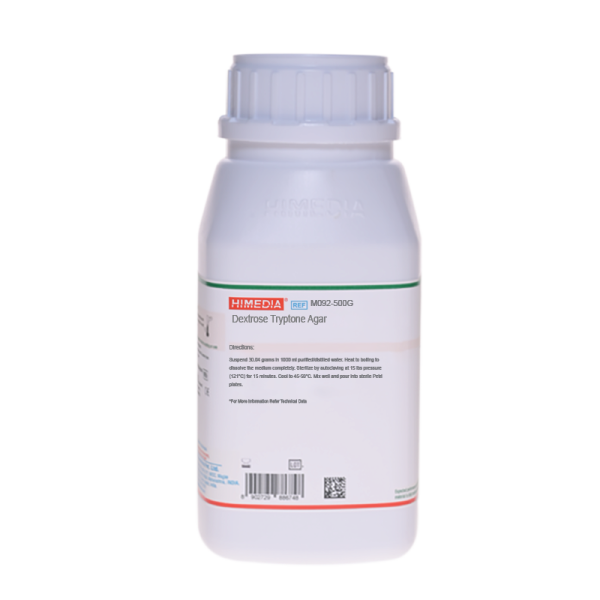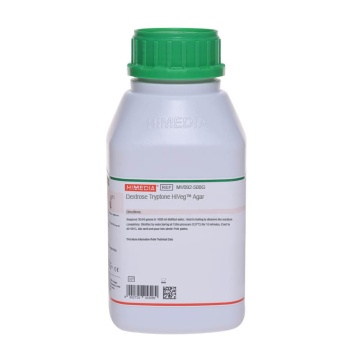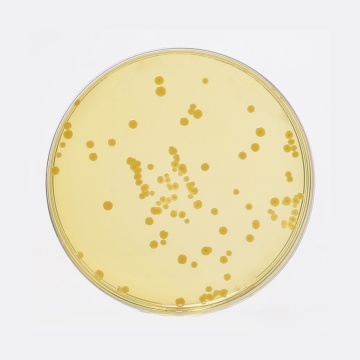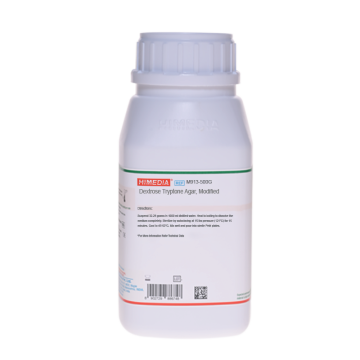 Your enquiry has been submitted
Your enquiry has been submitted
Dextrose Tryptone Agar
Mesophilic Sporeforming- Aerobic#CC293D
Intended Use
Recommended for detection and enumeration of mesophilic and thermophilic aerobic organisms in food.
Composition**
| Ingredients | Gms / Litre |
|---|---|
| Tryptone | 10.000 |
| Dextrose (Glucose) | 5.000 |
| Bromocresol purple | 0.040 |
| Agar | 15.000 |
| Final pH (at 25°C) | 6.7±0.2 |
**Formula adjusted, standardized to suit performance parameters
Directions
Suspend 30.04 grams in 1000 ml purified / distilled water. Heat to boiling the medium completely. Sterilize by autoclaving at 15 lbs pressure (121°C) for 15 minutes. Cool to 45-50°C. Mix well and pour into sterile Petri plates.
Principle And Interpretation
Canned foods are most often prone to flat-sour spoilage due to contamination by either mesophilic or thermophilic aerobic spore-formers. Inadequate heat processing is commonly responsible for flat-sour spoilage since spores of mesophilic bacteria are moderately resistant to moist heat. Also Bacillus stearothermophilus is the typical species responsible for this type of spoilage (4,5). Bacillus coagulans (Bacillus thermoacidurans, a soil organism) is frequently isolated from flat-sour spoilage of canned tomato and dairy products. In flat-sour spoilage, carbohydrates are fermented with the production of lower fatty acids, which sour the product. The small amount of gas produced does not affect the flat appearance of the ends of container. Dextrose Tryptone Agar, formulated by Williams is recommended for the detection and enumeration of thermophilic flat sour spoilage organisms (12). It is also recommended for general cultural studies by Cameron (3) and other associations (1,2,8,9). Dextrose Tryptone Agar is also useful for enumeration of mesophiles and thermophiles in cereal and cereal products, dehydrated fruits, vegetables and spices (10).
Tryptone provides essential nutrients to the organisms. Dextrose serves as an energy source by being the fermentable carbohydrate while bromo cresol purple is a pH indicator. Acid producing organisms produce yellow colonies. The plates should be incubated at 55°C for 48 hours in a humid incubator.
While using the agar media, serially diluted test sample are mixed with the media in sterile Petri dishes. Standard procedures issued by various associations should be followed for testing of samples.
Type of specimen
Food and dairy samples
Specimen Collection and Handling:
For food and dairy samples, follow appropriate techniques for sample collection and processing as per guidelines (1,10,11).
After use, contaminated materials must be sterilized by autoclaving before discarding.
Warning and Precautions :
Read the label before opening the container. Wear protective gloves/protective clothing/eye protection/ face protection. Follow good microbiological lab practices while handling specimens and culture. Standard precautions as per established guidelines should be followed while handling specimens. Safety guidelines may be referred in individual safety data sheets.
Limitations :
- 1.The pH of prepared medium needs to be checked after some period. If tested immediately it may go out of specification.
Performance and Evaluation
Performance of the medium is expected when used as per the direction on the label within the expiry period when stored at recommended temperature.
Quality Control
Appearance Light yellow to greenish yellow homogeneous free flowing powder
Gelling Firm, comparable with 1.5% Agar gel
Colour and Clarity of prepared medium Purple coloured, clear to slightly opalescent gel forms in Petri plates
Reaction Reaction of 3% w/v aqueous solution at 25°C. pH : 6.7±0.2
pH 6.50-6.90
Cultural Response
Cultural characteristics observed after an incubation at 54-56°C for 36-48 hours.
| Organism | Inoculum (CFU) | Growth | Recovery | Colour of colony |
|---|---|---|---|---|
| Bacillus brevis ATCC 8246 | 50-100 | good-luxuriant (with or without dextrose fermentation) | 50-70% | yellow |
| Bacillus coagulans ATCC 8038 | 50-100 | good-luxuriant | 50-70% | yellow |
| Bacillus stearothermophilus ATCC 7953 | 50-100 | good-luxuriant | 50-70% | yellow |
Storage and Shelf Life
Store between 10-30°C in a tightly closed container and the prepared medium at 20-30°C. Use before expiry date on the label. On opening, product should be properly stored dry, after tightly capping the bottle in order to prevent lump formation due to the hygroscopic nature of the product. Improper storage of the product may lead to lump formation. Store in dry ventilated area protected from extremes of temperature and sources of ignition. Seal the container tightly after use. Product performance is best if used within stated expiry period.
Disposal
User must ensure safe disposal by autoclaving and/or incineration of used or unusable preparations of this product. Follow established laboratory procedures in disposing of infectious materials and material that comes into contact with sample must be decontaminated and disposed of in accordance with current laboratory techniques (6,7).
Reference
- American Public Health Association, Standard Methods for the Examination of Dairy Products, 1978, 14th Ed., Washington D.C.
- Association of Official Analytical Chemists, 1978, Bacteriological Analytical Manual, 5th Edition, AOAC, Washington, D.C.
- Cameron E. J., 1936, J.Assoc. Official Agr. Chem., 19:433.
- Gordon R. E., Haynes and Pang C. H. N., 1973, The Genus Bacillus, Agriculture Handbook No. 407, U.S. Department of Agriculture, Washington, D.C.
- Hersom A. C., and Hulland E. D., 1964, Canned Foods, An Introduction to Their Microbiology, (Baumgartner) 5th Ed. Chemical Publishing Company, Inc. New York, N.Y.
- Isenberg, H.D. Clinical Microbiology Procedures Handbook 2nd Edition.
- Jorgensen, J.H., Pfaller, M.A., Carroll, K.C., Funke, G., Landry, M.L., Richter, S.S and Warnock., D.W. (2015) Manual of Clinical Microbiology, 11th Edition. Vol. 1.
- National Canners Association, 1954, A Laboratory Manual for the Canning Industry, 1st Edition, National Canners Associations, Washington.
- National Canners Association, 1968, Laboratory Manual for Food Caners and Processors, Vol. I
- Salfinger Y., and Tortorello M.L., 2015, Compendium of Methods for the Microbiological Examination of Foods, 5th Ed American Public Health Association, Washington, D.C.
- Wehr H. M. and Frank J. H., 2004, Standard Methods for the Microbiological Examination of Dairy Products, 17th Ed., APHA Inc., Washington, D.C.
- Williams O. B., 1936, Food Res., 1:217.
| Product Name | Dextrose Tryptone Agar |
|---|---|
| SKU | M092 |
| Product Type | Regular |
| Physical Form | Powder |
| Origin | Animal |
| Packaging type | HDPE |
| References | 1. Gordon R. E., Haynes and Pang C. H. N., 1973, The Genus Bacillus, Agriculture Handbook No. 407, U.S. Department ofAgriculture, Washington, D.C. 2.Hersom A. C., and Hulland E. D., 1964, Canned Foods, An Introduction to Their Microbiology, (Baumgartner) 5th Ed.Chemical Publishing Company, Inc. New York, N.Y. 3.Williams O. B., 1936, Food Res., 1:217. 4.Cameron E. J., 1936, J .Assoc. Official Agr. Chem., 19:433. 5.Association of Official Analytical Chemists, 1978, Bacteriological Analytical Manual, 5th Edition, AOAC, Washington,D.C. 6.American Public Health Association, 1972, Standard Methods for the Examination of Dairy Products, 13th Ed. APHA,Washington, D.C. 7.National Canners Association, 1968, Laboratory Manual for Food Caners and Processors, Vol. I 9.National Canners Association, 1954, A Laboratory Manual for the Canning Industry, 1st Edition, National CannersAssociations, Washington. 10.Downes F. P. and Ito K., (Eds.), 2001, Compendium of Methods for the Microbiological Examination of Foods, 4th Ed.,APHA, Washington, D.C. |
| Customized Product Available | No |











